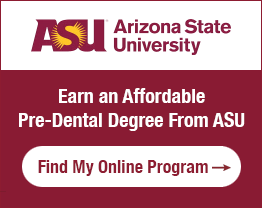Dental hygienists are recognized as licensed dental health professionals in every US jurisdiction. This means that to practice as a dental hygienist, all interested candidates must start by qualifying for state licensure through their state board of dentistry.
Although requirements for licensure vary from one jurisdiction to the next, what remains constant across the country are three basic requirements that must be met to practice dental hygiene in the US:
- Education
- National written examination
- Clinical examination
Featured Programs:
- Online
- Online
Education Requirement for Dental Hygienist Licensure
The majority of U.S. jurisdictions recognize dental hygiene programs that are accredited by the Commission on Dental Accreditation (CODA). The minimum educational requirement for licensure is an associate’s degree in dental hygiene, although it is also commonplace for candidates to pursue bachelor’s degrees. The American Dental Hygienists Association (ADHA) recognizes both associate’s and bachelor’s-level programs as meeting the requirements for entry-level jobs.
There are currently 335 entry-level CODA-accredited dental hygiene programs in the United States. CODA-accredited programs in dental hygiene may be offered through a number of different types of institutions, such as four year colleges/universities, community colleges, dental schools, and technical/vocational schools.
In addition to associate’s and bachelor’s degrees, there are 55 degree completion programs in dental hygiene that allow licensed dental hygienists who already hold an associate’s degree to complete a bachelor degree program in dental hygiene or a related field.
Degree completion programs are typically designed as one of the following:
- Bachelor of Science in Health Sciences
- Bachelor of Science in Allied Health
- Bachelor of Science in Dental Hygiene
About 80 percent of all CODA-accredited programs in dental hygiene culminate in a clinical rotation.
Coursework in a dental hygiene programs can be broken down as follows:
General education courses
- Psychology
- Sociology
- English
- Speech
Science courses
- Biology
- Physiology
- Microbiology
- Anatomy
- Biochemistry
- Pathology
Dental science courses
- Dental anatomy
- Head and neck anatomy
- Radiology
- Periodontology
Dental hygiene courses
- Oral health education
- Community dental health
- Clinical periodontics
- Ethics for the healthcare professional
- Dental health education and methods
- Dental hygiene practicum
Although not a requirement for licensure, it is common for dental hygienists who want to advance their career in the healthcare field to pursue a master’s degree in a related field, such as practice administration, human resources, and diagnosis and treatment planning.
National Written Examination Requirement for Dental Hygienist Licensure
The Joint Commission on National Dental Examinations (an independent agency of the ADA) National Board Dental Hygiene Examination (NBDHE) is the standard assessment for dental hygienist licensure in the United States. The NBDHE assists state boards in evaluating qualifications for licensure, ensuring that all requirements are met.
The NBDHE is designed to fulfill a U.S. jurisdiction’s written examination requirement, although the use of the NBDHE is at the discretion of the specific state or jurisdiction. Currently, all U.S. jurisdictions recognize the NBDHE, including all 50 states, Washington D.C., Puerto Rico, Guam, and the Virgin Islands.
The NBDHE assesses the candidate’s ability to understand basic information in dental hygiene, including biomedical and dental hygiene sciences. It also assesses the candidate’s ability to apply that information in a problem-solving context.
The NBDHE 350 multiple-choice questions within two components:
Component A: Consists of 200 questions that address three, major areas:
- Scientific basis for dental hygiene practice
- Provision of clinical dental hygiene services
- Community health/research principles
Component B: Consists of 150 case-based items that assess situations related to adult and child patients. Component B is designed to assess functions that a dental hygienist should be able to perform, such as interpreting radiographs, using preventive agents, providing supportive treatment service, performing periodontal procedures, and assessing patient characteristics, among others.
The NBDHE is administered through Pearson VUE testing centers located throughout the United States.
Clinical Examination Requirements for Dental Hygienist Licensure
In addition to passing the NBDHE, all U.S. jurisdictions require dental hygienist candidates to take and pass a clinical (practical) examination. Regional clinical dental hygiene examinations are designed to assess the clinical competency of candidates and provide state dental boards with the information needed to make valid licensing decisions.
All regional clinical examinations consist of skill-specific patient treatment in a clinical setting.
There are currently five regional testing agencies:
- Council of Interstate Testing Agencies (CITA)
- Central Regional Dental Testing Services (CRDTS)
- North East Regional Board (NERB) of Dental Examiners
- Southern Regional Testing Agency (SRTA)
- Western Regional Examining Board (WREB)
While some states, such as Kentucky, recognize the completion of any of the above agencies’ exams, other states have more specific requirements. For example, dental hygienist candidates in New York State must take and pass a clinical examination through NERB.
All examinations include a treatment selection component and a radiographic component, while the CITA, NERB, and WREB also offer a computer component. Further, CRDTS, NERB, and STRA assess a candidate’s clinical skills in the administration of local anesthesia if allowed in the state in which they are seeking licensure.
Currently, the only two states that have their own, independent, clinical examinations are California (California Clinical Dental Hygienist Examination) and Delaware (Delaware Practical Board Examination in Dental Hygiene).
Additional Dental Hygienist Licensure Requirements
In addition to meeting the education, national examination, and clinical examination requirements for dental hygiene licensure, candidates for state licensure may also need to:
- Pass a state jurisprudence examination
- Achieve and maintain Basic Life Support (BLS) certification
- Apply for certification in specific areas, such as nitrous oxide administration
- Pass a criminal background check
- Obtain a child abuse clearance
- Provide proof of up-to-date immunizations
- Complete training in infection control and barrier precautions so as to prevent the transmission of HIV and other communicable diseases


